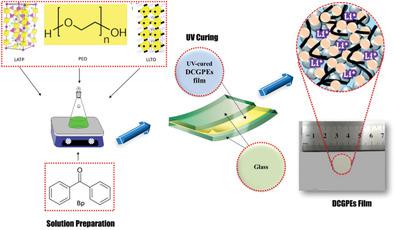当前位置:
X-MOL 学术
›
Adv. Mater. Interfaces
›
论文详情
Our official English website, www.x-mol.net, welcomes your feedback! (Note: you will need to create a separate account there.)
In Situ Curing Technology for Dual Ceramic Composed by Organic–Inorganic Functional Polymer Gel Electrolyte for Dendritic‐Free and Robust Lithium–Metal Batteries
Advanced Materials Interfaces ( IF 5.4 ) Pub Date : 2020-08-31 , DOI: 10.1002/admi.202000830 Sajid Hussain Siyal 1, 2 , Muhammad Sufyan Javed 3, 4 , Ashique Hussain Jatoi 5 , Jin‐Le Lan 1 , Yunhua Yu 1 , Muhammad Saleem 6 , Xiaoping Yang 1
Advanced Materials Interfaces ( IF 5.4 ) Pub Date : 2020-08-31 , DOI: 10.1002/admi.202000830 Sajid Hussain Siyal 1, 2 , Muhammad Sufyan Javed 3, 4 , Ashique Hussain Jatoi 5 , Jin‐Le Lan 1 , Yunhua Yu 1 , Muhammad Saleem 6 , Xiaoping Yang 1
Affiliation

|
Lithium–metal batteries (LiMBs) are promising energy storage devices due to the high capacity and minimum negative electrochemical potential. Nevertheless, their concrete applications remain disturbed by unbalanced electrolyte–electrode interfaces, limited electrochemical window, and high risk. Herein, a novel strategy to obtain dual ceramic‐based electrolytes that possesses a great potential in energy storages and higher level of energy densities in LiMBs. Dual‐ceramic (lithium aluminum titanium phosphate ‐lithium lanthanum titanium oxide (LATP‐LLTO)) gel polymer electrolyte (DCGPE) film developed via the curable system aims to prepare flexible Li+ interpenetrating network film to integrate the two ceramic structures with polyethylene oxide (PEO) to yield the free‐standing electrolytes film for better battery safety and desired interfacial stability. The DCGPEs films present a satisfactory electrochemical performance, including good ionic conductivity, large transference number, and wide electrochemical stability window at room temperature. Most importantly, the fundamental function of LATP and LLTO is to support building a stable solid‐electrolyte‐interphase and limits the growth of dendrites. Thus, prepared dual ceramic‐based electrolytes effectively render to inhibit lithium dendrite growth in a symmetrical cell Li//PEO + 10% LATP + 15% LLTO//Li test during charge/discharge at a current density of 2 and 0.25 mA cm−2 above 2400 h without short‐circuiting occurrence at room temperature. Besides, the battery assembled of LiFePO4/PEO + 10% LATP + 20% LLTO/Li exhibits superior cyclic stability with high Coulombic efficiency. This study recommends that the binary network structures of Li‐ion conductor help to design a prime solution of promising electrolyte for high‐performance LiMBs applications.
中文翻译:

有机和无机功能聚合物凝胶电解质组成的双陶瓷原位固化技术,用于无树突和坚固的锂金属电池
锂金属电池(LiMBs)由于其高容量和最小的负电化学势而成为有前途的储能设备。然而,它们的具体应用仍然受到不平衡的电解质-电极界面,有限的电化学窗口和高风险的困扰。本文介绍了一种获得双重陶瓷基电解质的新颖策略,该电解质在储能方面具有巨大潜力,并且在LiMBs中具有更高的能量密度。通过可固化系统开发的双陶瓷(锂铝钛磷酸盐-锂镧钛氧化物(LATP-LLTO))凝胶聚合物电解质(DCGPE)膜旨在制备柔性Li +互穿网络膜,将两个陶瓷结构与聚环氧乙烷(PEO)集成在一起,形成独立式电解质膜,从而具有更好的电池安全性和所需的界面稳定性。DCGPEs薄膜具有令人满意的电化学性能,包括良好的离子电导率,较大的转移数和在室温下宽的电化学稳定性窗口。最重要的是,LATP和LLTO的基本功能是支持建立稳定的固体电解质界面,并限制树枝状晶体的生长。因此,在电流密度为2和0.25 mA cm的情况下,充放电期间对称的Li // PEO + 10%LATP + 15%LLTO // Li测试中,制得的双陶瓷基电解质有效地抑制了锂枝晶的生长。高于2400 h时,−2在室温下不会发生短路。此外,由LiFePO 4 / PEO + 10%LATP + 20%LLTO / Li组装而成的电池具有优异的循环稳定性和高库仑效率。这项研究建议,锂离子导体的二元网络结构有助于为高性能LiMBs应用设计有前途的电解质的主要解决方案。
更新日期:2020-10-26
中文翻译:

有机和无机功能聚合物凝胶电解质组成的双陶瓷原位固化技术,用于无树突和坚固的锂金属电池
锂金属电池(LiMBs)由于其高容量和最小的负电化学势而成为有前途的储能设备。然而,它们的具体应用仍然受到不平衡的电解质-电极界面,有限的电化学窗口和高风险的困扰。本文介绍了一种获得双重陶瓷基电解质的新颖策略,该电解质在储能方面具有巨大潜力,并且在LiMBs中具有更高的能量密度。通过可固化系统开发的双陶瓷(锂铝钛磷酸盐-锂镧钛氧化物(LATP-LLTO))凝胶聚合物电解质(DCGPE)膜旨在制备柔性Li +互穿网络膜,将两个陶瓷结构与聚环氧乙烷(PEO)集成在一起,形成独立式电解质膜,从而具有更好的电池安全性和所需的界面稳定性。DCGPEs薄膜具有令人满意的电化学性能,包括良好的离子电导率,较大的转移数和在室温下宽的电化学稳定性窗口。最重要的是,LATP和LLTO的基本功能是支持建立稳定的固体电解质界面,并限制树枝状晶体的生长。因此,在电流密度为2和0.25 mA cm的情况下,充放电期间对称的Li // PEO + 10%LATP + 15%LLTO // Li测试中,制得的双陶瓷基电解质有效地抑制了锂枝晶的生长。高于2400 h时,−2在室温下不会发生短路。此外,由LiFePO 4 / PEO + 10%LATP + 20%LLTO / Li组装而成的电池具有优异的循环稳定性和高库仑效率。这项研究建议,锂离子导体的二元网络结构有助于为高性能LiMBs应用设计有前途的电解质的主要解决方案。

























 京公网安备 11010802027423号
京公网安备 11010802027423号